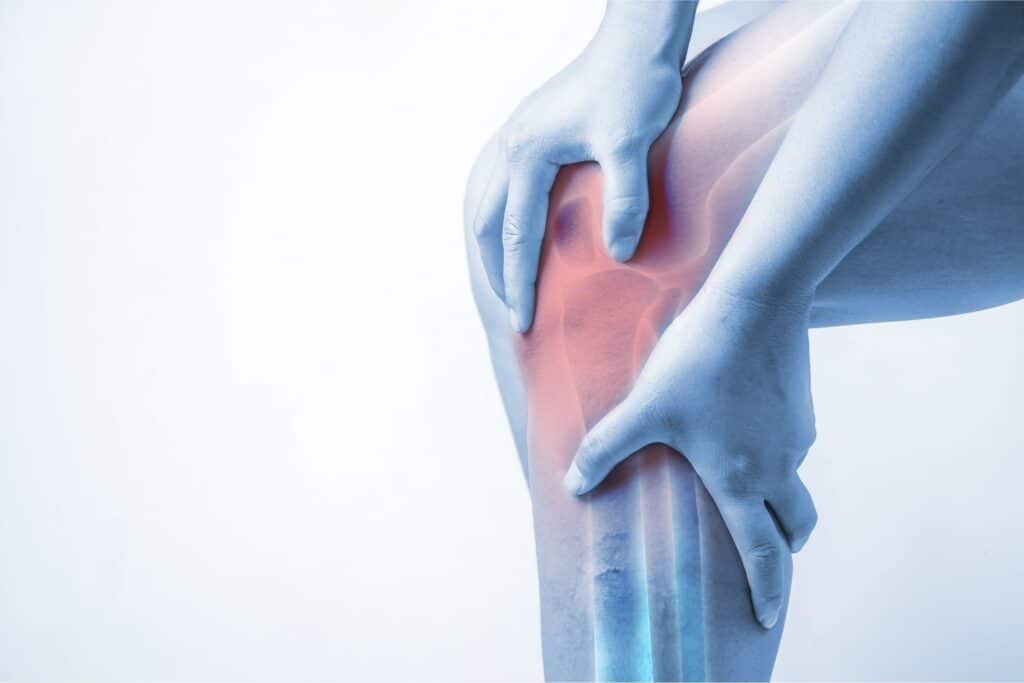Yes, you can manage knee pain without surgery; here’s how. This article will outline effective strategies such as medications, physical therapy, and lifestyle changes to help you find relief.
Read on to learn how you can take control of your knee pain without surgical intervention.
Can you manage knee pain without surgery? Here’s how to explore these options further.
Key Takeaways
- Understanding the causes of knee pain, such as injuries and conditions like osteoarthritis, is crucial for effective management.
- Non-surgical treatments, including medications, physical therapy, and lifestyle changes, can effectively alleviate knee pain and improve mobility.
- Alternative therapies, such as injections and acupuncture, can complement conventional treatments to provide additional relief from knee pain.
Understanding the Causes of Knee Pain
Knee pain affects people of all ages, so understanding its underlying causes is crucial. More than 20% of people over the age of 40 experience chronic knee pain, a statistic that underscores its prevalence. Addressing knee pain is necessary because it often signals an issue within the knee joint or elsewhere in the body.
Whether it’s due to knee injuries, such as meniscus tears and ruptured cruciate ligaments, or conditions like osteoarthritis and rheumatoid arthritis, identifying the cause is the first step towards effective management.
If knee pain impacts your quality of life or limits activities, seeking medical help is necessary.
Common Knee Problems
Common knee problems that can lead to chronic pain include torn ligaments, osteoarthritis, and rheumatoid arthritis. Osteoarthritis, a degenerative joint disease commonly associated with aging, leads to pain and stiffness in the knee joint. Rheumatoid arthritis, an autoimmune condition, causes joint inflammation and can severely affect mobility and quality of life.
A torn meniscus, often resulting from sudden twisting motions during physical activities, is another common knee injury. These conditions can significantly impact daily activities and overall mobility, making it vital to address them promptly.
How Body Weight Affects Knee Pain
Excess body weight adds strain to the knees, increasing pain and inflammation. The pressure on the knee joint can be substantial; for example, the force exerted on the knees when running can be six times a person’s body weight. Similarly, activities like climbing stairs or performing squats can amplify this pressure up to ten times.
A healthy weight reduces stress on the knees and alleviates pain. Managing body weight through diet and exercise can significantly reduce knee pain and improve overall joint health.
Non-Surgical Treatments for Knee Pain
Various non-surgical treatments effectively manage knee pain. The treatment options can vary depending on the underlying causes of knee pain, but they generally aim to provide pain relief and improve mobility.
These treatments can include medications, physical therapy, knee braces, and knee pain treatments. These options can be effective in managing knee pain and potentially delaying the need for surgical intervention.
Medications for Pain Relief
Medications play a significant role in providing pain relief for knee pain. Commonly prescribed medications include NSAIDs and Paracetamol, which help alleviate pain and reduce inflammation. Paracetamol is often recommended to be taken with meals for effective pain relief.
If over-the-counter medications are insufficient, consulting a healthcare professional for alternatives is advised.
Topical analgesics, such as Flexiseq, can also offer temporary pain relief for knee pain.
Physical Therapy and Exercise
Physical therapy is essential for reducing knee pain, and improving mobility.
Physical therapy before surgery can strengthen the knee and aid recovery. Low-impact exercises, such as swimming, biking, and yoga, are recommended for knee pain relief.
Regular physical activity enhances muscle strength and flexibility, alleviating knee pain.
Rehabilitation exercises, including walking in a swimming pool, using an exercise bike, and performing chair squats, can support the knee joint and promote healing.
Knee Braces and Supports
Knee braces and supports are valuable tools for managing knee pain. These devices are designed to protect or support the knee joint, providing stability during various activities.
Different types of braces can help stabilize the knee joint, relieve pain, and promote mobility.
Knee braces and supports effectively manage knee pain and enhance the ability to perform daily activities. They offer a practical solution for those looking to reduce pain and prevent further injury.
Alternative Therapies for Managing Knee Pain
Alternative therapies can offer effective management of knee pain without the need for surgery. These therapies complement conventional treatments, providing additional pain relief and improving joint function.
Some of the alternative therapies that can help manage knee pain and promote healing include:
- Injections
- Supplements
- Manual therapy techniques
- Acupuncture
Injections and Supplements
Injections are valuable for managing knee pain, reducing inflammation, and improving joint function. Hyaluronic acid injections, for example, involve injecting a synthetic gel-like substance into the knee joint, which can provide pain relief for up to 6 to 12 months in Osteoarthritis.
Supplements like glucosamine and chondroitin can also help prevent cartilage from wearing down and improve knee health.
Choosing from Cortisone injections, hyaluronic acid treatments, and joint supplements allows for a tailored approach to managing knee pain.
Manual Therapy Techniques
Manual therapy techniques, such as massage therapy, can significantly alleviate knee pain by applying pressure to the muscles and joints to relieve tension.
Chiropractic care improves knee pain by adjusting and aligning the knee joint and surrounding muscles, aiding mobility and reducing discomfort.
Techniques like myofascial release help relax and stretch tight tissues surrounding the knee, providing further pain relief.
Acupuncture and Other Treatments
Acupuncture aids in managing knee pain by promoting the release of endorphins, which alleviate pain. It can be particularly effective in relieving knee pain from osteoarthritis.
The overall significant pain relief potential of acupuncture makes it a valuable option for managing knee conditions, providing pain relief for many patients.
Lifestyle Changes to Reduce Knee Pain
Lifestyle modifications can play a significant role in managing knee pain. Physical therapy and lifestyle changes can effectively reduce pain and improve mobility.
Staying physically active, maintaining a healthy weight, and adopting an anti-inflammatory diet are key strategies to ease knee pain and prevent future knee pain.
Anti-Inflammatory Diet
An anti-inflammatory diet can reduce knee pain and promote overall health.
The Mediterranean diet, rich in fruits, vegetables, and healthy fats, is particularly beneficial for lowering inflammation and joint pain.
Incorporating non-acidic fruits, vegetables, whole grains, and healthy fats from fish, avocados, nuts, and seeds can significantly reduce pain and inflammation, enhancing mobility and quality of life.
Maintaining a Healthy Weight
A healthy weight alleviates stress on the knees and reduces pain. Excess body weight can worsen knee osteoarthritis by increasing the load on the joint during movement. Each pound lost removes approximately four pounds of pressure from the knee joint, highlighting the benefits of weight loss for knee health.
Ergonomic Adjustments
Ergonomic adjustments in daily life reduce knee pain and prevent further damage. Knee braces and orthotic shoe inserts provide support and stability, reducing pressure on the knees.
Using a walking stick, placing a pillow between your knees while sleeping, and maintaining good posture during daily activities can significantly reduce strain on your knees and promote healing.
When to Consider Surgical Intervention
While non-surgical treatments can be effective, there are times when surgery might be necessary for knee pain. Knee surgery may be required when non-surgical treatments fail to relieve pain or improve mobility.
Evaluating the extent of knee pain and its impact on the affected knee determines the necessity of surgical options.
Assessing the Need for Surgery
Criteria for knee surgery include persistent pain, swelling, and stiffness that limit mobility. Younger patients with lesser arthritis may benefit from surgeries that delay knee replacement, while those with severe joint deterioration might see significant improvement in their quality of life through knee replacement surgery.
Patients should weigh the pros and cons of non surgical treatment rehabilitation and surgical reconstruction, discussing risks, benefits, and alternatives with their healthcare team.
Preparing for Surgery
Preparing for knee surgery involves consultations with healthcare providers, including rheumatologists, orthopedic surgeons, or sports medicine specialists. Pre- and post-surgical physical therapy is crucial in the recovery process, helping to strengthen the knee and promote healing.
Summary
Managing knee pain without surgery is possible through a combination of non-surgical treatments, alternative therapies, and lifestyle changes. By understanding the causes of knee pain and exploring various treatment options, you can take control of your knee health and improve your quality of life.
Remember, it’s important to seek medical advice before starting any treatment to ensure its safety and appropriateness. With the right approach, you can manage knee pain effectively and enjoy a more active, pain-free life.
Frequently Asked Questions
What are the common causes of knee pain?
Common causes of knee pain are damaged ligaments, osteoarthritis, rheumatoid arthritis, and meniscus tears, often stemming from injuries or degenerative changes in the joint. Prompt consultation with a healthcare professional is advisable for proper diagnosis and treatment.
How does body weight affect knee pain?
Excess body weight significantly increases pressure on the knee joint, leading to pain and inflammation. Maintaining a healthy weight can alleviate stress on the knees and reduce pain.
What non-surgical treatments are available for knee pain?
Non-surgical treatments for knee pain encompass medications, physical therapy, knee braces, injections, supplements, manual therapy, and acupuncture. These methods can effectively alleviate pain and enhance mobility.
How can lifestyle changes help reduce knee pain?
Implementing lifestyle changes such as an anti-inflammatory diet, weight management, and ergonomic adjustments can significantly alleviate knee pain and mitigate the risk of further injury. These proactive steps are essential for enhancing overall joint health.
When should I consider knee surgery?
You should consider knee surgery if non-surgical treatments do not alleviate persistent pain, swelling, or stiffness that restrict your daily activities. If these symptoms hinder your mobility, surgery may be a viable option.

